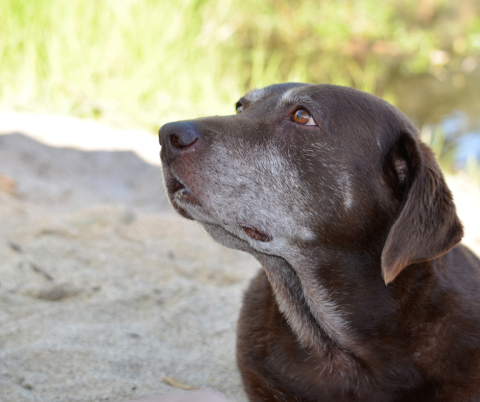In the third and final article from Mike Davis, RCVS Specialist, explores the different approaches to managing canine osteoarthritis.
PART 3
Clinical evidence for successful management strategies in canine osteoarthritis (OA)
Most veterinary orthopaedic specialists' advise a multimodal approach to treating OA. Some of the main ones are discussed below.
A. Therapeutic Medications
Many dogs with OA are treated with anti-inflammatory drugs which can be corticosteroids, non-steroidal anti-inflammatories or others such as monoclonal antinbodies. However, there is no single drug that will be effective in all animals, in fact for most drugs positive outcomes are only seen in about 50% of cases treated. In addition, many licensed drugs have adverse-effects, some serious, especially in older dogs that may have concurrent clinical or sub-clinical age-related diseases.
As an example, in clinical trials the licensed priprant (grapiprant) improved pain scores in just 48.1% of dogs compared to an improvement seen in 31.3% for dogs given a placebo (P=0.0315) – not a big difference, and adverse effects including vomiting was very common in dogs given the pripant (more than one in 10 animals treated), and diarrhoea and inappetence were common - between one and 10 animals in 100 animals treated.
Therapeutic choices should be based on safety and efficacy in each case, and pre-administration screening and/or post-administration may be needed.
B. Nutritional interventions

In a lifetime study of 48 Labrador Retrievers 25% reduction in food intake delayed the onset of arthritis (based on annual radiography) by 6 years, and none of the dogs in the diet restricted group developed clinical signs of osteoarthritis (Lawler and others 2008).
Weight loss improves lameness scores (Moreau et al, 2010; Marshall et al, 2010) by 6% (Marshall et al, 2010) to 11% to 18% (Impellizeri et al, 2000)
Omega-3 fatty acids
The “gold standard” highest levels of evidence are systematic reviews of the scientific literature involving randomised controlled clinical trials (RCTs) (Hariton 2018) and there have been three published relating to the polyunsaturated Omega-3 fatty acids eicosapentaenoic acid (EPA) and docosahexaenoic acid (DHA) (Barbeau-Grégoire and others 2022; Magalhães and others 2021; Aragon and others 2007). EPA and DHA supplementation has been shown to be positively associated with clinical improvements in veterinary patients with a variety of diseases which are common:
a. Osteoarthritis (Kampa and others 2023; Corbee and others 2013; Mehler and others 2016; Moreau and others 2013; Roush and others 2010a and 2010b; Fritsch and others 2010; Lascelles and others 2010; Rychel 2009) by reducing inflammation, pain and lameness. EPA/DHA supplementation can can also reduce the dose required of non-steroidal anti-inflammatory drugs (NSAIDs) such as carprofen (Fritsch and others 2010). which is beneficial if they are to be used in animals at risk of developing serious adverse effects.
b. Inflammatory skin disorders including atopy (Bond and others 2021a 2021b; Logas and others 2021; Lourenço and others 2018; Saridomichelakis and Olivry 2016; Mueller and others 2005; Abba and others 2005: Nesbitt and others 2003; Harvey 1999; Lechowski and others 1998; Bond and Lloyd 1994; Scott and others 1992); Scott 1990), poor skin quality (Combarros and others 2020) by reducing inflammation and pruritus.
c. Cardiovascular conditions (von Haehling and others 2017; Jain and others 2015; Freeman and others 2006; Freeman and others 1998) improving the management of heart failure and delaying mortality.
d. Keratoconjunctivitis sicca (dry eye) (Downie and others 2019; Silva and others 2018; Rashid 2008)
e. Renal disease (Plantinga and others 2005)
f. Periodental disease (Azzi and others 2020; Dodi 2015
g. Cancer (lymphoma) in dogs (Ogilvie and others 2000)
h. Behaviour modification (Rahimi 2018)
i. Canine epilepsy (Matthews and others 2012)
Being fatty acids EPA/DHA contain about 8.5 kcals ME per gram, so supplements do provide additional calories for the animal which should be taken account of in overweight or obese individuals. Other uncommon adverse effects may include vomiting, diarrhoea and halitosis and potential rare adverse effects include altered platelet function, gastrointestinal adverse effects, impaired wound healing, lipid peroxidation, potential for nutrient excess and toxin exposure, weight gain, altered immune function, effects on glycaemic control. insulin sensitivity, and nutrient-drug interactions.
Glucosamine and Chondroitin
Glucosamine and chondroitin nutritional supplements are widely used in the management of canine osteoarthritis but the scientific evidence to support their efficacy has always been conflicting (Kampa and others 2023) and a recent systematic review (Barbeau-Grégoire 2022) found a very marked lack of efficacy leading to the Authors’ conclusion that they should no longer be recommended for pain management in canine and feline osteoarthritis.
Body Condition Score (BCS)
Control food intake to avoid overweight and keep dogs lean with a body condition score (BCS) of under 5/9. In a lifetime study of 48 Labrador Retrievers 25% reduction in food intake delayed the onset of arthritis (based on annual radiography) by 6 years, and none of the dogs in the diet restricted group developed clinical signs of osteoarthritis (Lawler and others 2008).

C. Regenerative therapies.
In one study, intraarticular stem cell transplantation in fifty-eight dogs that were suffering from osteoarthritis in the elbow (42 animals), hip (5), knee (8), ankle (2), and hock (1) resulted in 83% of the patients having improved or retained improvement in lameness over a 4-5 treatment period with no major adverse events reported. (Kriston-Pál and others 2020)
D. Disease modification in osteoarthritis medications
In humans at least three agents (sprifermin), a cathepsin K inhibitor, and lorecivivint) appear to slow the progression of structural damage in early clinical trials (Katz and others 2022). Sprifermin was associated with both dose-dependent reductions in loss of total cartilage thickness loss and actual increases in cartilage thickness over two years compared with placebo (Hochberg and others 2019). The cathepsin K inhibitor was associated with statistically significant reductions in 3D MRI bone shape change compared with placebo at 26 weeks( Conaghan 2019) and lorecivivint, a Wnt signaling inhibitor (Yazici 2017) showed less radiographic joint space narrowing than placebo over 24 weeks. However, none of these potential interventions has been granted a license for use in humans or dogs.
E. Physiotherapy, laser (photomodulation) therapy, ultrasound, cold and hot treatments, water baths
Based on positive evidence from human studies there has been a surge in interest and application of physiotherapy, laser (photomodulatory therapy, ultrasound, cold or hot treatments, water baths and aquatherapy in pets with OA. Unfortunately, there are few scientific studies reporting positive outcomes. (Mille and others 2022) however there are some supporting the use of physiotherapy (Crook and others 2007), interferential current therapy (shockwave treatment) (Upariputti and others 2018; Ferrier and others 2017; Millis and others 2011; Muellar and others 2007; Fitch and others 2005), laser treatment (Barale and others 2022), Looney and others 2018) however more robust studies are required before these treatment modalities can be strongly recommended.
CONCLUSIONS
The management of canine osteoarthritis is usually multimodal and no single strategy will work for all individuals. The scientific evidence supports the use of licensed veterinary medical products – anti-inflammatory drugs (corticosteroids and NSAIDs), analgesic, monoclonal antibodies.
Scientific evidence also supports the use of Omega-3 fatty acids (EPA/DHA) supplementation and complete therapeutic diets for which clinical trials have been published. Evidence to support other modalities such as physiotherapy, laser (photomodulation) therapy, ultrasound, cold and hot treatments, aquatherapy is lacking and more studies are required to validate efficacy and safety.



